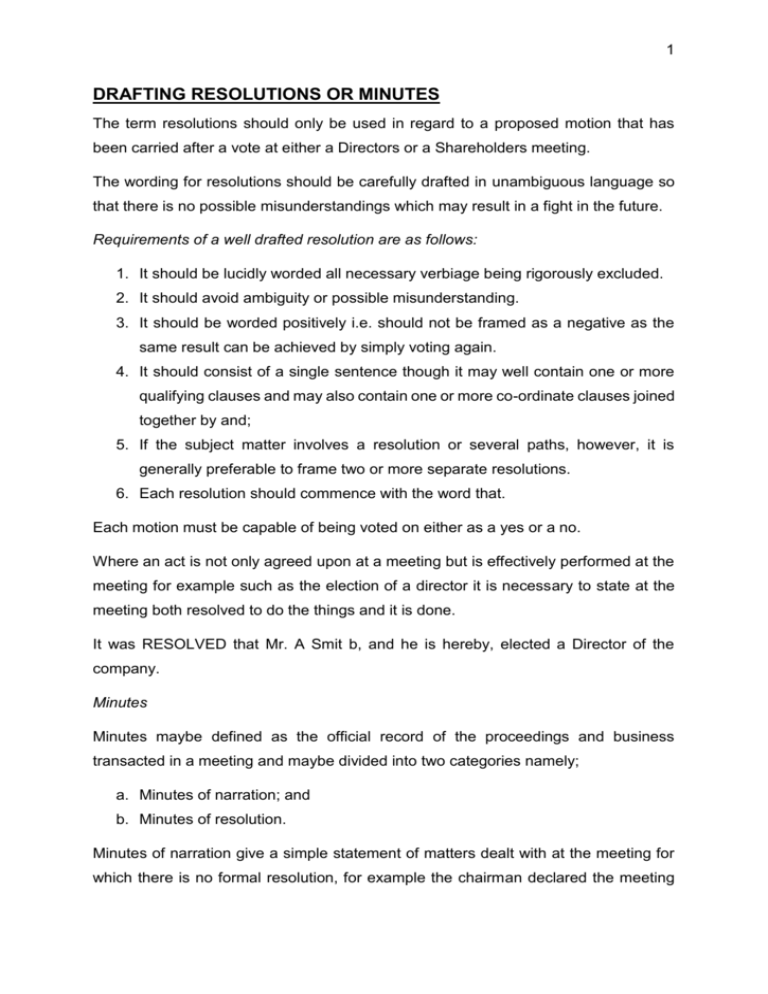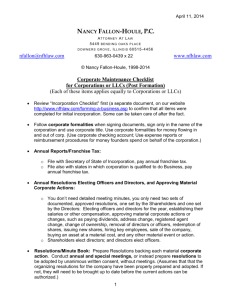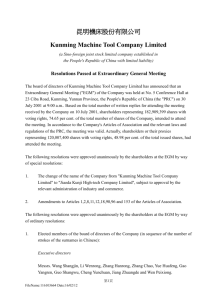RELATED AND INTER RELATED PERSONS
advertisement

1 DRAFTING RESOLUTIONS OR MINUTES The term resolutions should only be used in regard to a proposed motion that has been carried after a vote at either a Directors or a Shareholders meeting. The wording for resolutions should be carefully drafted in unambiguous language so that there is no possible misunderstandings which may result in a fight in the future. Requirements of a well drafted resolution are as follows: 1. It should be lucidly worded all necessary verbiage being rigorously excluded. 2. It should avoid ambiguity or possible misunderstanding. 3. It should be worded positively i.e. should not be framed as a negative as the same result can be achieved by simply voting again. 4. It should consist of a single sentence though it may well contain one or more qualifying clauses and may also contain one or more co-ordinate clauses joined together by and; 5. If the subject matter involves a resolution or several paths, however, it is generally preferable to frame two or more separate resolutions. 6. Each resolution should commence with the word that. Each motion must be capable of being voted on either as a yes or a no. Where an act is not only agreed upon at a meeting but is effectively performed at the meeting for example such as the election of a director it is necessary to state at the meeting both resolved to do the things and it is done. It was RESOLVED that Mr. A Smit b, and he is hereby, elected a Director of the company. Minutes Minutes maybe defined as the official record of the proceedings and business transacted in a meeting and maybe divided into two categories namely; a. Minutes of narration; and b. Minutes of resolution. Minutes of narration give a simple statement of matters dealt with at the meeting for which there is no formal resolution, for example the chairman declared the meeting 2 duly constituted and the minutes of a meeting of the board held on the 5 th January 2013 were read and signed by the chairman as a correct record. Minutes of a resolution record only the resolutions passed and are pre-fixed by the word resolved; That Mr. Dhlamini be, and he is hereby appointed as assistant secretary to the company with effect from the 1st February 2013. RELATED AND INTER RELATED PERSONS INTRODUCTION The term related or interrelated person is widely used around the world including on the JSE and there is a whole chapter provided in the listing requirements devoted to transactions between related parties. As a company secretarial practitioner this is something you need to know as the term related person appears in the companies Act 80 times. These terms have been included in the Companies Act to increase transparency and improve the standards of corporate governance. These terms are used in the context of safeguarding minority shareholders against the majority of shareholders or directors taking unfair advantage of these relationships. Where two parties transact the transaction may be between 2 people who are related which may be to the detriment of minority shareholders. E.g. where a loan is made to a director. In terms of s 45 a special resolution is required. What is the position if the loan is made to another person who has a relationship with the director! It may also be that related or interrelated parties act independently or at arm’s length and the act empowers the court, the takeover regulation panel or the Companies Tribunal from exempting such parties from the provisions of the act. They define three relationships namely between or amongst two or more: 1. natural persons. 2. juristic persons. 3. Natural and juristic persons 3 Section 1 of the Act contains the following definitions: Related – when used in respect of 2 or more persons who are connected to one another in the manner contemplated in s 2(1) (a) (b) and (c). Inter-related - when used in respect of three or more person mean persons who are related to one another in a linked series of relationships such that two of the persons are related in a manner as defined in 2(1) and one of them is related to the third in any such matter and so forth in an unbroken series. relationship includes the connection existing between any two or more persons who are related or inter related as determined in a in terms of 2. Were 2 persons are related s 2(1) (a) (b) and (c). Note the word persons includes juristic version. S 2 provides that with the purposes of the Act any two natural persons are related to one another if they are married or live together in a relationship similar to a marriage or separated by more than two degrees of natural or adopted consanguinity or affinity. This includes children, grandchildren, parents, grandparents, siblings and inlaws including grandparents in law. S 2 (1) (b) provides that a natural person is related to a juristic person if the natural person directly or indirectly controls the juristic person as determined in accordance with s 2 (2) Section 2 (1) (c) provides that for all purposes of the Act two juristic persons are related to one another if; 1. Either of them directly or indirectly controls the other, or the business of the other as determined in accordance with 2(2) or 2. Either is a subsidiary of the other, or; 3. A person directly or indirectly controls each of them or the business of each of them as determined in accordance with Section 2.2. This includes a holding company and it is direct and indirect subsidiaries as well as fellow subsidiaries of a common controlling shareholder irrespective of whether the controlling shareholder is a natural or juristic person. 4 THE MEANING OF CONTROL OF A JURISTIC PERSON The word control is capable of numerous meetings. The words ‘control of a company’ is defined in s 2 (2) (a) For the purposes of s 2(1) a person (first person) controls a company or its business 1. if that company is a subsidiary of the first person as determined in terms of s 3(1)(a). This means the subsidiary by definition is always related to its holding company and vice versa. 2. The first person together with any related or inter-related person is directly or indirectly able to exercise or control the majority of the voting rights associated with securities of that company whether pursuant to a shareholder agreement or otherwise or Has the right to appoint or elect or control the appointment or election of directors of that company who controls a majority of the votes at a board meeting. Control at board level is something that is tested by the majority of the votes that the directors control. There is a common law duty that whichever way director’s vote they must carry out their fiduciary duty which is a common law principle. A Close Corporation and Trust are included in these definitions and it is just a question of control. S 2(2)(d) is a catch all and takes the meaning of control even further. APPLICATION FOR EXEMPTION In terms of Section 2(3) one can ask for exemption for the various related parties to act independently, this exemption can be an application to Court, Company’s Tribunal or the Take-Over Regulation panel which may exempt any person from the application of the abovementioned provisions. The application must show that there is sufficient evidence to conclude that the person acts independently of any related or interrelated person.







